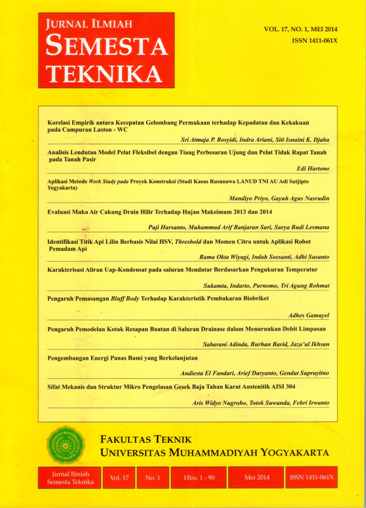Analisis Lendutan Model Pelat Fleksibel dengan Tiang Perbesaran Ujung dan Pelat Tidak Rapat Tanah Pada Tanah Pasir
DOI:
https://doi.org/10.18196/st.v17i1.410Abstract
Problems in sandy soil may occur when sand has low density, uniform gradation and thick deposit. Flexible plate foundation may used in this condition but plate deflection still high. To reduce deflection and to improve soil density, piles were used to support the plate. Installing piles made foundation system stiffer. The objectives of this study are to studies about behavior of plates and plate with pile on sandy soil. Plate deflection was observed with variation of plate thickness, bottom pile enlargement, and soil-plate-pile interaction (free standing pile and piled foundation). 1,2 x 1,2 x 1,2 m box container filled with sandy soil was used as soil media. Square and rectangular plexiglass plate were used to modelled plate. Steel pipe with 2,5 cm in diameter were used as pile model. The behavior of the plates were observed under loading (point load). The results shows that plate deflections were affected on plate thickness, bottom pile enlargement and soil-plate-pile interaction. For a ticker plate, contact surface between plate and soil was wider. For the 40 cm x 10 cm plates with base pile enlargement, deflections were found to reduced up to 21,26%. The ‘piled foundation’ on 40 cm x 10 cm plates, (installing with 20 cm pile length, and 10 cm spacing between pile), deflections were reduced 83,63% compared with free standing foundation.
Downloads
Published
How to Cite
Issue
Section
License
Semesta Teknika is licensed under a Creative Commons Attribution 4.0 International License.
Authors who publish with this journal agree to the following terms:
- Authors retain copyright and grant the journal right of first publication with the work simultaneously licensed under a Creative Commons Attribution License that allows others to share the work with an acknowledgement of the work's authorship and initial publication in this journal.
- Authors are able to enter into separate, additional contractual arrangements for the non-exclusive distribution of the journal's published version of the work (e.g., post it to an institutional repository or publish it in a book), with an acknowledgement of its initial publication in this journal.
- Authors are permitted and encouraged to post their work online (e.g., in institutional repositories or on their website) prior to and during the submission process, as it can lead to productive exchanges, as well as earlier and greater citation of published work (See The Effect of Open Access).









